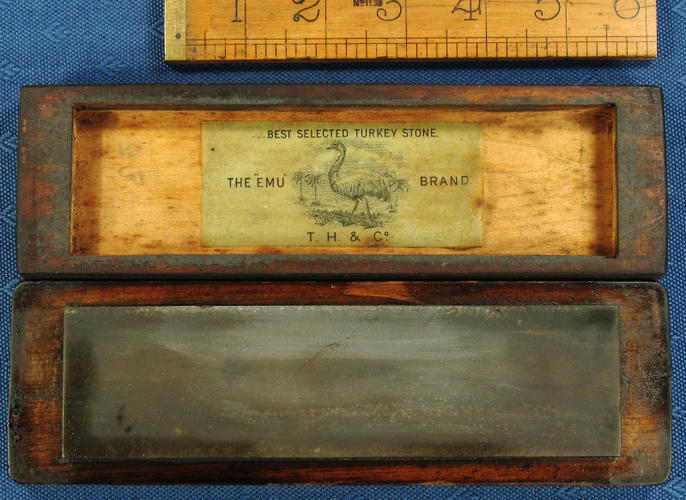Results 31 to 37 of 37
Thread: Oil Stone Turkey
-
09-02-2014, 07:04 PM #31Senior Member

- Join Date
- Mar 2009
- Posts
- 1,211
Thanked: 202
I would be in Old Turkey pack too. Take care of it as it is very fragile.
-
The Following User Says Thank You to adrspach For This Useful Post:
905Driver (09-02-2014)
-
09-02-2014, 08:06 PM #32Junior Member

- Join Date
- Sep 2014
- Location
- Canada
- Posts
- 2
Thanked: 0
-
12-23-2014, 09:12 AM #33Junior Member

- Join Date
- Aug 2013
- Location
- Norfolk, England
- Posts
- 20
Thanked: 0
To recompense this forum for the help you've given me in ID'ing my green slate-ish stone,
I think I can offer a tiny fact-oid on the Turkey Stone.
I own a small, cased, branded Turkey Stone. In 2010 I posted to the Oldtools list thusly:I also found this from the 1897 Catalogue of Charles Strelinger, a VERY large mail
Rummaging through my pile of stones (I keep buying these things)
I found this:

The label in the lid says:
BEST SELECTED TURKEY STONE
THE "EMU" BRAND (with picture to suit)
T. H. & Co.
The stone itself is a blue/gray colour, like
many slate stones. However the texture is a little
coarser than fine slates, and certainly coarser
than a Charnley Forrest. The cutting rate
is higher too.
I worked a blade (and old chisel) using white spirit before the photo
to attempt to have the colour as natural as possible
I also used SiC paper to reveal "unused" stone (the lighter, bluer
area near the top in the photo).
The stone is lightly used, and unusually worn; the surface
is convex in width, and also has two humps in length.
Not the "overall concavity" normally seen on stones
used for woodworking.
order tool company in the USA:
I note that the company that made my stone "T H & Co" is the same as that ofThe next to be considered is the TURKEY OIL STONE, which was in more general use before the introduction of the Washita. This stone is of a grayish color, and of very smooth, even grit. It cuts somewhat faster than the Washita, and also leaves a better edge. The main trouble with Turkey oil stones is that they are rarely free from cracks and fissures, and are easily broken. If it were not for this fact, the Turkey stone would be much more popular.
"h_bud_gl" up thread, although the logos are different.
BugBear
-
12-23-2014, 03:34 PM #34

I never tried a Turkey stone, though I read about them. I cannot recall where, but in another old tome the Turkey was said to be highly regarded by carpenters, wood workers of the nineteenth century and beyond. Those members who got hold of some of the current stuff said that they were inconsistent in quality and easily broken, so I decided to take their word for it and be satisfied with what I had. Yours is a beautiful example of a vintage stone. Thanks for sharing it.
Be careful how you treat people on your way up, you may meet them again on your way back down.
-
12-23-2014, 03:46 PM #35Junior Member

- Join Date
- Aug 2013
- Location
- Norfolk, England
- Posts
- 20
Thanked: 0
-
12-23-2014, 08:36 PM #36Senior Member

- Join Date
- Mar 2009
- Posts
- 1,211
Thanked: 202
I do have few of OTs of different sizes in my collection and I use them on my sharp tools. at present I have two smaller ones on my table as we speak (used with oil). Some of them are also cracked as described however what I have noticed that if the stone is cracked but those pieces are not misplaced then there is no noticeable effect for honing. The only problem is when it is misplaced.
I like them as they are quite quick and I can use them with gauges and not too much worry about pressure while honing.
One of the better informed people here is Vasilis.
-
12-23-2014, 10:04 PM #37Senior Member



- Join Date
- Apr 2008
- Location
- Essex, UK
- Posts
- 3,816
Thanked: 3164
Thomas Hazeon was a London Merchant, selling others peoples goods, like arkansas, whittle hill, grecian oilstones, turkey stones - this was around 1893-5 though, when they used 'CutPhast' as a trademark.
They were based at 10 Bishopsgate Ave., EC, London, from 1905 then 1938 then at 20 Strafford Ave, Ealing from 1939. It seems that nazi bombing put paid to their premises.
Some saws were simply marked "Hazeon, London" but originally the company was very much like AB Salmon (ie in the late 1800s) and specialised in the same things such as honestones, grindstones, carpenters tool baskets, scythe stones, etc. The stuff they retailed will tell you nothing about its origins, though. T H & Co made grinding wheels for wet grinding, as well as the troughs the wheels were set into and on which the grinders sat.
FYI there was a lot of confusion about Turkey Stones - not only were there several different types, but some did not cut as finely as others. All work better with a light oil. Some of the confusion was 'spin' in which stones of similar cutting characteristics were called Turkey Stones by dishonest sellers, but of course they are easily spottable.
Regards,
Neil
-
The Following User Says Thank You to Neil Miller For This Useful Post:
Hirlau (12-23-2014)


 20Likes
20Likes LinkBack URL
LinkBack URL About LinkBacks
About LinkBacks






 Reply With Quote
Reply With Quote
